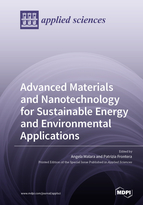Advanced Materials and Nanotechnology for Sustainable Energy and Environmental Applications
A special issue of Applied Sciences (ISSN 2076-3417). This special issue belongs to the section "Nanotechnology and Applied Nanosciences".
Deadline for manuscript submissions: closed (20 May 2022) | Viewed by 15858
Special Issue Editors
Interests: nanomaterials; synthesis; electrospinning; fibres; materials characterization; sensors; catalysis; catalysts
Special Issue Information
Dear Colleagues,
Materials play a particularly important role in the technological development of a society. Consequently, the continuous demand for more advanced and sophisticated applications is closely linked to the availability of innovative materials. Although aspects related to the study, the synthesis. and the applications of materials are of interdisciplinary interest, in the last few years, great attention has been paid to the development of advanced materials for environmental preservations and sustainable energy technologies, such as gaseous pollutant monitoring, wastewater treatment, catalysis, CO2 valorization, green fuel production, energy saving, water adsorption, and clean technologies.
This Special Issue aims at covering the current design, synthesis, and characterization of innovative advanced materials, as well as novel nanotechnologies able to offer promising solutions to the these pressing themes.
Dr. Angela Malara
Prof. Dr. Patrizia Frontera
Guest Editors
Manuscript Submission Information
Manuscripts should be submitted online at www.mdpi.com by registering and logging in to this website. Once you are registered, click here to go to the submission form. Manuscripts can be submitted until the deadline. All submissions that pass pre-check are peer-reviewed. Accepted papers will be published continuously in the journal (as soon as accepted) and will be listed together on the special issue website. Research articles, review articles as well as short communications are invited. For planned papers, a title and short abstract (about 100 words) can be sent to the Editorial Office for announcement on this website.
Submitted manuscripts should not have been published previously, nor be under consideration for publication elsewhere (except conference proceedings papers). All manuscripts are thoroughly refereed through a single-blind peer-review process. A guide for authors and other relevant information for submission of manuscripts is available on the Instructions for Authors page. Applied Sciences is an international peer-reviewed open access semimonthly journal published by MDPI.
Please visit the Instructions for Authors page before submitting a manuscript. The Article Processing Charge (APC) for publication in this open access journal is 2400 CHF (Swiss Francs). Submitted papers should be well formatted and use good English. Authors may use MDPI's English editing service prior to publication or during author revisions.
Keywords
- advanced materials
- novel synthesis
- electrospinning
- sustainable energy
- catalysis
- clean energy
- green fuel
- environmental applications
- sensors
- nanotechnologies







